Tying a karate belt correctly is an essential skill for martial arts practitioners. Whether you are a beginner or a seasoned practitioner, knowing how to tie your karate belt properly is crucial for both functionality and respect for the art. In this step-by-step guide, we will walk you through different karate belt tying techniques, ensuring that you achieve a neat and secure knot every time.
Key Takeaways:
- Learning how to tie a karate belt correctly is crucial for martial arts practitioners.
- Follow our step-by-step guide for different karate belt tying techniques.
- Tying your karate belt properly reflects your commitment to attention to detail and respect for the martial arts tradition.
- Ensure evenness, smooth out any wrinkles, and tighten the knot securely but comfortably.
- Adjust any uneven belt ends before proceeding with the tying process.
Why It Matters: Tying Your Karate Belt Correctly
When learning the art of karate, mastering the proper way to tie a karate belt is essential. It goes beyond just appearances; it signifies your dedication to precision and respect for the rich tradition of martial arts. Tying your karate belt correctly is an important practice that every martial arts practitioner should adopt.
By taking the time to tie your karate belt properly, you demonstrate your commitment to attention to detail. This attention to detail carries over into your training, enabling you to perform techniques with greater precision and efficiency. It sets the tone for your practice and reflects your attitude towards martial arts as a whole.
Moreover, tying your karate belt correctly shows respect for the martial arts tradition. The karate belt, known as the obi, is not just a piece of fabric; it bears significance and symbolism. It represents your progress, discipline, and dedication to continuous learning.
When you tie your karate belt with care and intention, it becomes a visual reminder of the values and principles upheld in karate training. It serves as a constant source of motivation and inspiration, encouraging you to strive for excellence in every aspect of your martial arts journey.
Take pride in mastering the proper technique of tying your karate belt. It not only enhances your overall appearance in the dojo but also signifies your commitment to personal growth and respect for the martial arts tradition.
| Bullet Points | Benefits |
|---|---|
| Shows commitment to attention to detail | Enhances precision in techniques |
| Reflects respect for the martial arts tradition | Upholds values and principles of karate |
| Symbolizes progress, discipline, and dedication | Motivates and inspires continuous learning |
Method 1: Traditional Karate Belt Tying
One of the most common and traditional methods for tying a karate belt is as follows:
- Step 1: Start by folding the belt in half to find the center point.
- Step 2: Place the center of the belt on your navel, allowing the two ends to hang evenly.
- Step 3: Cross the ends behind your back, bringing them back around to the front.
- Step 4: Cross one end over the other, making an “X” shape.
- Step 5: Bring the end that was originally on top back underneath both layers and pull it through the loop created by the “X”.
- Step 6: Tighten the knot by pulling both ends evenly.
- Step 7: Adjust the belt to ensure it is even and centered on your waist.
The traditional method of tying a karate belt may take some practice to master, but with time, it will become second nature. Pay attention to the positioning of the belt and strive for evenness. This method not only secures the belt firmly but also offers a clean and professional appearance.
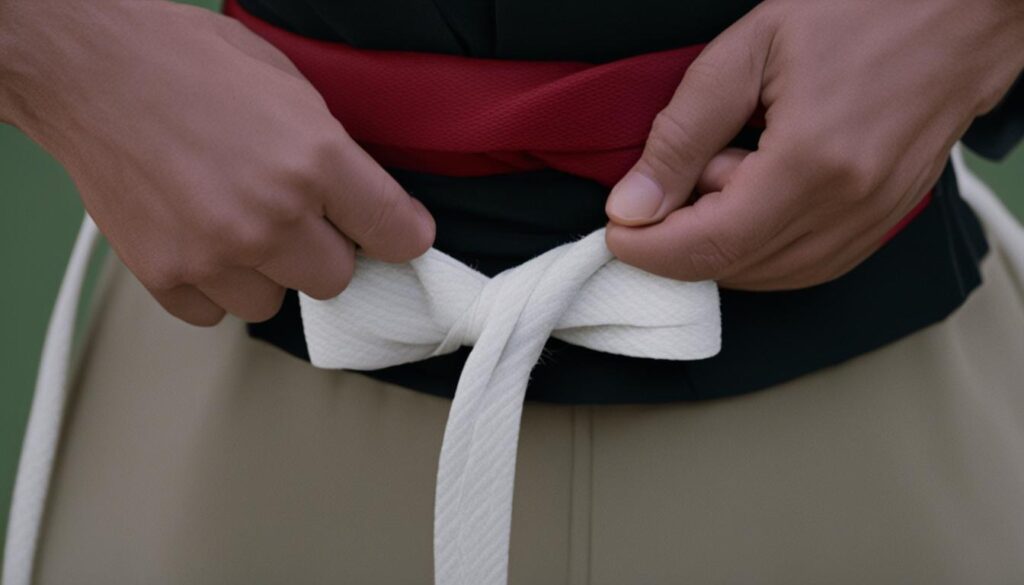
Mastering the traditional method of tying a karate belt is an important foundation for all martial arts practitioners. It demonstrates your commitment to the art and pays homage to the centuries-old tradition.
Method 2: Alternative Karate Belt Tying
If you’re looking to add some variety to how you tie your karate belt, try the alternative method. This technique offers different variations and creates a unique knot style.
To begin, wrap one end of the belt around your waist twice. Then, tuck the other end under the layers created by the first wrap. This will secure the belt and prevent it from coming undone during your training sessions.
This alternative method has its advantages. Not only does it provide a flatter knot, but it also creates a smoother line in the back. It’s a great way to showcase your personal style and stand out on the martial arts mat.
| Variation | Description |
|---|---|
| Knot Variation 1: | Take the end of the belt and pass it under the layers created by the first wrap. Then, bring it through the loop formed and tighten. |
| Knot Variation 2: | Instead of passing the end of the belt through the loop, bring it over the first wrap and tuck it under the layers. Pull it snugly to secure the knot. |
| Knot Variation 3: | Wrap the end of the belt around the layers twice, similar to the initial wrap. Then, tuck it through the loop created and tighten. |
Experiment with these variations to find the one that suits you best. Whether you prefer a sleeker knot or a more intricate style, the alternative method allows for creative expression while still maintaining a secure belt.
Tips for Tying a Karate Belt
When it comes to tying your karate belt, a few helpful hints can ensure that you achieve a secure and professional knot. Follow these tips to master the art of tying your karate belt:
- Use a Mirror for Guidance: Tying a karate belt can be tricky, especially when starting out. Utilize a mirror to observe your technique and make necessary adjustments. This visual aid will help you ensure that your belt is evenly positioned and properly tightened.
- Ensure Evenness: A well-tied karate belt should have an even appearance, with both ends of the belt extending to a similar length. Take the time to adjust the belt’s positioning before tying the knot to achieve a neat and balanced look.
- Smooth Out Any Wrinkles: Before tying the knot, smooth out any wrinkles or twists in the belt. This will give your belt a polished and professional appearance, reflecting your attention to detail and respect for the martial arts tradition.
- Tighten the Knot Securely but Comfortably: It is essential to secure your karate belt firmly to avoid it coming undone during training. However, ensure that the knot is not overly tight, as it should allow for comfortable movement and breathing. Striking the right balance is key.
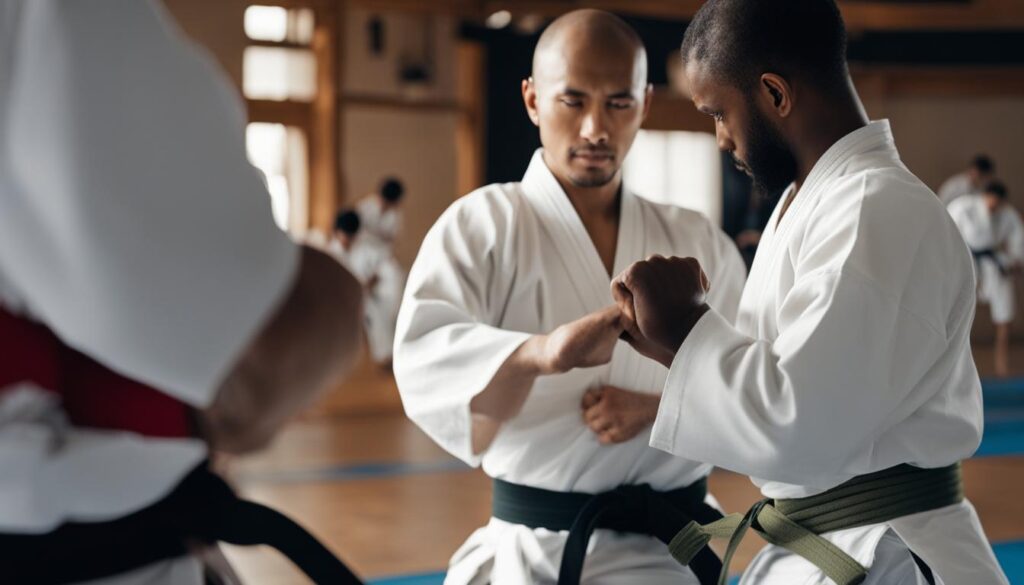
By following these tips, you can enhance your karate training experience and present yourself with confidence. Remember, tying a karate belt is not just a practical skill but also an opportunity to showcase your dedication to the art and its traditions.
Now that you’ve mastered the art of tying a karate belt, let’s explore how to troubleshoot uneven belt ends in the next section.
Troubleshooting: Uneven Belt Ends
While tying a karate belt, you may encounter the problem of uneven belt ends. This can be frustrating, but don’t worry – it’s a common issue that can be easily fixed. Here’s what you can do:
- Adjust the belt: If you notice that the ends of your karate belt are uneven, try sliding the belt around on your waist. This simple adjustment can help align the ends and make them more even.
- Fix the unevenness: Once you’ve adjusted the belt, take a moment to fix the unevenness before proceeding to the next step. You can do this by straightening the belt and ensuring that both ends are of equal length.
By following these steps, you can ensure that your karate belt is neatly tied with even ends. This not only adds to the overall aesthetic appeal but also reflects your attention to detail and respect for the martial arts tradition.
Now that you know how to fix uneven belt ends, you can confidently proceed with tying your karate belt correctly. Remember, even the smallest details matter in martial arts, and taking the time to fix this issue demonstrates your commitment to excellence.
Karate Belt Tying for Different Martial Arts
The methods described in this guide can be applied to various martial arts disciplines, such as taekwondo or jiujutsu. Regardless of the specific martial art you practice, understanding how to tie your belt correctly is crucial for both functional and symbolic reasons. Although the techniques may vary slightly, the underlying principles remain the same.
When tying your belt for different martial arts, it is essential to adapt the technique based on your specific style. Each style may have its own unique way of tying the belt or specific requirements for knot placement. By learning the correct method for each martial art, you demonstrate your respect for the discipline and honor its traditions.
For example, in taekwondo, the belt is usually tied with a double knot, emphasizing stability and security. In jiujutsu, the knot may be tied off to the side, allowing for more freedom of movement during grappling.
Regardless of the martial art, the process of tying the belt is an opportunity to focus your mind, prepare for training, and embrace the values of discipline and respect that are integral to martial arts.
Make sure to carefully follow the instructions provided in the earlier sections of this guide to ensure your belt is tied securely and neatly. By mastering the art of belt tying, you not only enhance your appearance but also embody the spirit of your martial art.
Maintaining a Neatly Tied Karate Belt
To ensure that your karate belt remains neatly tied, it is important to focus on its maintenance during your training sessions. By following a few simple steps, you can keep your belt secure and looking sharp.
First and foremost, always check that the knot is tight and secure before starting your training. A loose knot may come undone during vigorous movements, which can be distracting and interrupt your focus. Take a moment to tighten the knot, ensuring it is snug and firm.
If you find that the tightness of the knot starts to become uncomfortable during your training, there is no need to worry. Adjustments can be made during breaks or transitions to ensure both comfort and security. Simply loosen or tighten the knot as necessary, keeping it at a level that is comfortable for you.
Remember, a neatly tied karate belt not only enhances your appearance but also reflects your dedication to the martial arts. By maintaining a tight and secure knot, you demonstrate your attention to detail and respect for the traditions of karate.
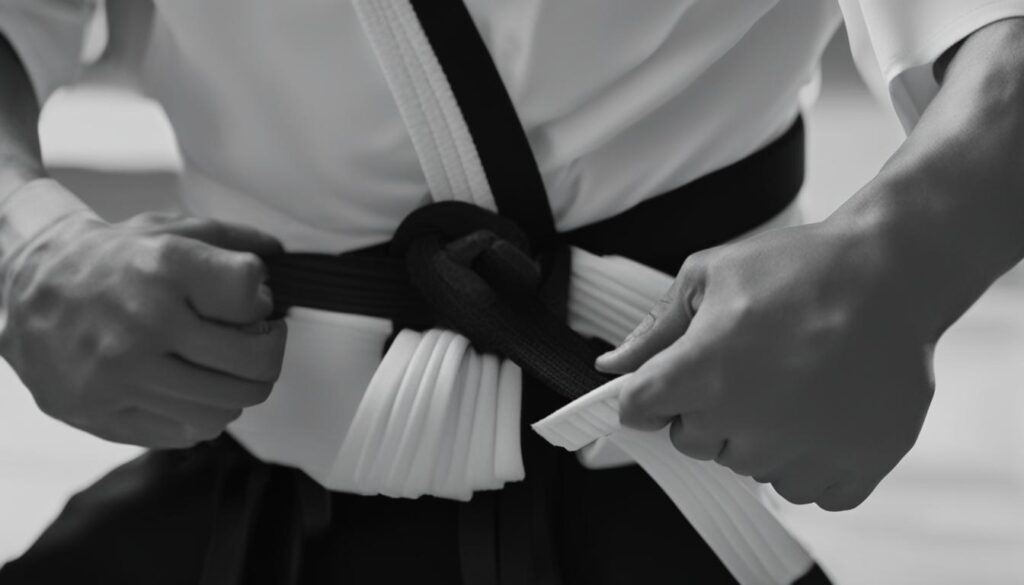
Tips for Karate Belt Maintenance
- Regularly check the knot to ensure it remains tight and secure.
- Clean your karate belt following the manufacturer’s instructions, if necessary.
- Avoid washing your belt too frequently, as it may cause the colors to fade.
- Store your belt in a cool and dry place to prevent any deterioration.
Following these simple maintenance tips will help you keep your karate belt looking neat and professional. By taking care of your belt, you demonstrate your commitment to your martial arts journey and highlight the importance of respect and discipline.
The Symbolism of a Well-Tied Karate Belt
A well-tied karate belt symbolizes discipline, dedication, and respect for the martial arts. It serves as a visual reminder of the values and principles upheld in karate training.
When you tie your karate belt correctly, you are not only ensuring that it stays securely in place during practice but also embracing the deeper meaning behind this simple act. The process of tying your belt requires focus, attention to detail, and precision, all of which are core principles of karate. Each knot represents the effort you put into your training and the commitment you have made to the martial arts.
Just as discipline and dedication are integral to your practice, they are also essential qualities in life. By meticulously tying your karate belt, you are reinforcing these qualities and allowing them to become ingrained in your character. The act of tying the belt serves as a daily reminder to maintain discipline, both on and off the mat.
Furthermore, the karate belt acts as a symbol of respect. It signifies respect for your instructors, your training partners, and the teachings of the martial arts. When you tie your belt with care and intention, you are demonstrating your reverence for the traditions and lineage of karate.
Image:
Folding Your Gi (Uniform) Properly
In addition to tying your karate belt correctly, it is important to fold your gi (uniform) properly. Neatly folding your karate gi not only maintains its cleanliness and appearance but also shows respect for the martial arts tradition. Follow these steps to ensure you fold your gi correctly:
Step 1: Lay Your Gi Flat
To begin folding your karate gi, find a clean, flat surface to work on. Lay your gi flat with the front side facing down.
Step 2: Fold the Sleeves In
First, fold in the sleeves of your gi. Take one sleeve and fold it across the chest, aligning it with the center of the gi. Repeat this step with the other sleeve.
Step 3: Fold the Gi in Half
Next, fold the bottom of the gi up towards the top, halving it vertically. Make sure the sleeves are neatly tucked inside the fold.
Step 4: Roll Up the Gi
Starting from the bottom of the folded gi, begin tightly rolling it up. Continue rolling until you reach the top of the gi, creating a compact roll.
Step 5: Store or Carry
Once your gi is rolled up, you can store it in your gym bag or carry it with ease. Properly folding your gi ensures that it remains in good condition and is ready for your next training session.
Remember, taking the time to fold your karate gi correctly is a small but significant way to honor your martial arts practice and maintain a sense of discipline. Now that you know how to tie your karate belt and fold your gi, you’re fully equipped to showcase your respect for the art of karate.
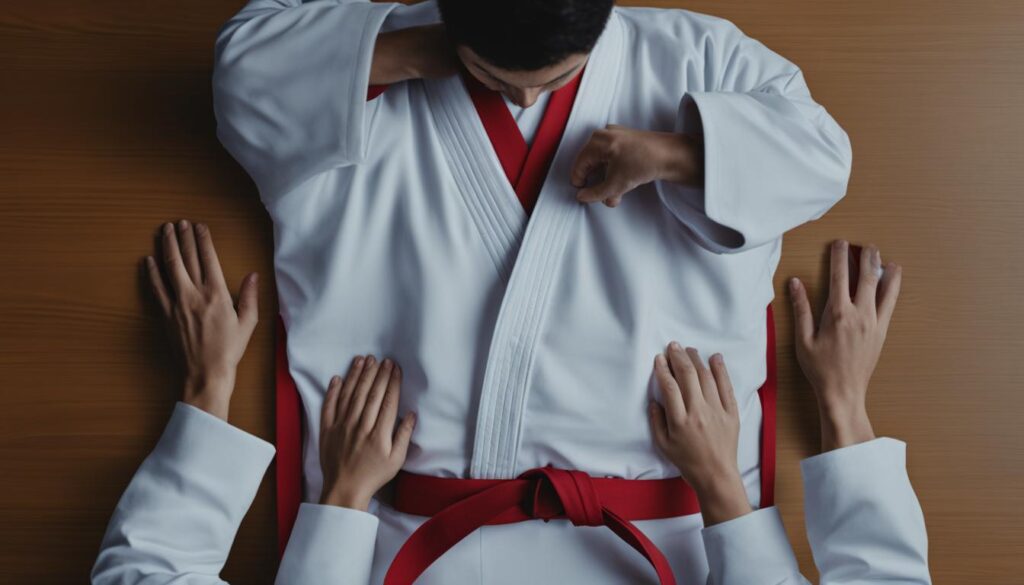
| Step | Description |
|---|---|
| 1 | Lay your gi flat with the front side facing down. |
| 2 | Fold the sleeves in, one at a time, aligning them with the center of the gi. |
| 3 | Fold the bottom of the gi up, halving it vertically. |
| 4 | Start rolling the gi tightly from the bottom up. |
| 5 | Store or carry the rolled up gi. |
The Importance of a Neatly Folded Gi
Folding your gi properly demonstrates respect for the martial arts and ensures that it remains clean and wrinkle-free. A neatly folded gi also helps prolong its lifespan.
When you take the time to fold your karate gi correctly, you show appreciation for the art and discipline of karate. It’s not just about keeping your training gear organized; it’s about upholding the values and traditions of the martial arts.
A neatly folded gi also helps maintain its cleanliness. By folding your gi after each training session, you prevent dirt and sweat from accumulating and ensure that it’s ready for your next practice. This not only promotes good hygiene but also extends the life of your gi, saving you money in the long run.
Additionally, a properly folded gi is free from wrinkles. Wrinkles can be distracting and uncomfortable during training, hindering your movements and affecting your performance. By taking the time to fold your gi neatly, you eliminate wrinkles and create a smooth, comfortable fit when you put it on.
Overall, folding your gi properly is a small but significant act that reflects your dedication to the martial arts. It shows that you value the training and the traditions associated with karate. So, take the time to fold your gi with care, and you’ll not only be showcasing your respect for the art, but you’ll also be ensuring that your gi stays clean, wrinkle-free, and ready for your next training session.
| Reasons to Fold Your Gi Properly |
|---|
| Show respect for the martial arts |
| Maintain cleanliness and hygiene |
| Prevent wrinkles for a comfortable fit |
| Prolong the lifespan of your gi |
Modeling Attention to Detail for Young Students
Parents play a crucial role in guiding and shaping their young children’s development. Teaching kids to tie karate belts is not just a practical skill but an opportunity to instill important values through karate training.
By ensuring that children learn the correct way to tie their karate belts, parents can teach them the value of effort. Tying a belt requires patience, practice, and attention to detail. It teaches children that mastering a skill requires perseverance and dedication.
Furthermore, teaching kids the importance of cleanliness goes hand in hand with tying karate belts correctly. A neat and tidy appearance reflects respect for oneself, the martial arts discipline, and other practitioners. It cultivates a sense of discipline and encourages children to take pride in their appearance.
Respect is another crucial value that parents can instill through karate training. By emphasizing the importance of tying belts correctly, parents can teach their children to respect martial arts traditions and honor the history and values associated with karate.
When parents take the time to teach their children how to tie karate belts, they are modeling attention to detail and demonstrating the importance of small actions in achieving bigger goals. This not only helps children develop essential life skills but also fosters their overall growth and character development.
Encouraging kids to pay attention to details and perform tasks with care can have far-reaching effects beyond their martial arts journey. The values instilled through karate training can shape their approach to other aspects of life, such as academics, relationships, and personal development.
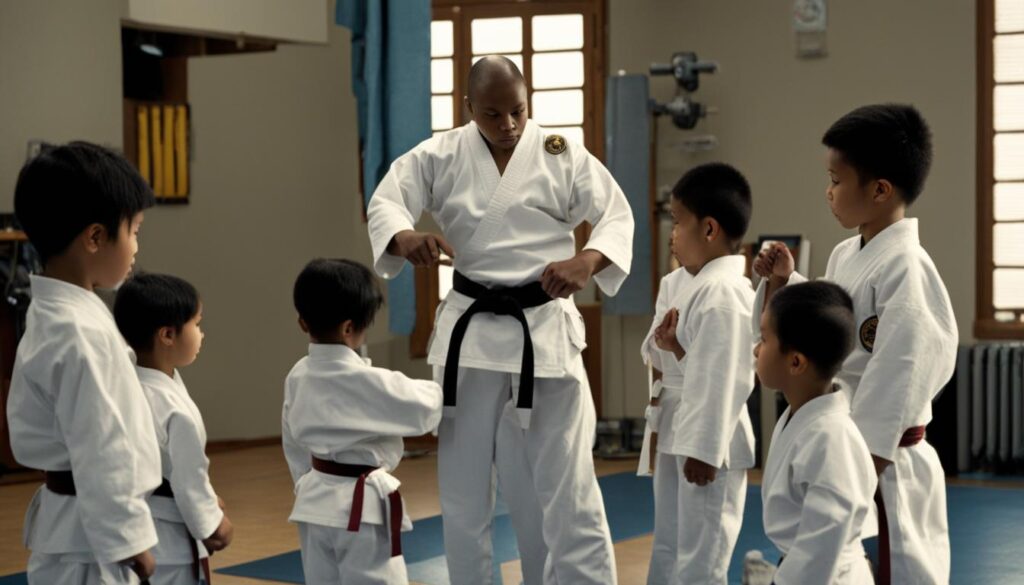
| Benefits of Teaching Kids to Tie Karate Belts | Values Instilled through Karate Training |
|---|---|
| Develops patience and perseverance | Effort and dedication |
| Promotes cleanliness and attention to appearance | Respect for oneself and others |
| Teaches the importance of following traditions and respecting martial arts history | Discipline and honor |
| Fosters attention to detail and the significance of small actions | Growth mindset and character development |
The Impact of Mindset in Karate Training
In karate training, your mindset plays a crucial role in shaping your overall experience and growth as a martial artist. The way you approach your training, from the moment you tie your karate belt, can greatly impact your performance and development. A positive attitude and a focused mindset can make all the difference in achieving success on the mats.
Tying your karate belt correctly is not just about aesthetics. It is a ritual that represents discipline and respect for the martial arts tradition. When you take the time to tie your belt with care and precision, you are setting the tone for your training session. It serves as a reminder to approach your practice with dedication, focus, and an open mindset.
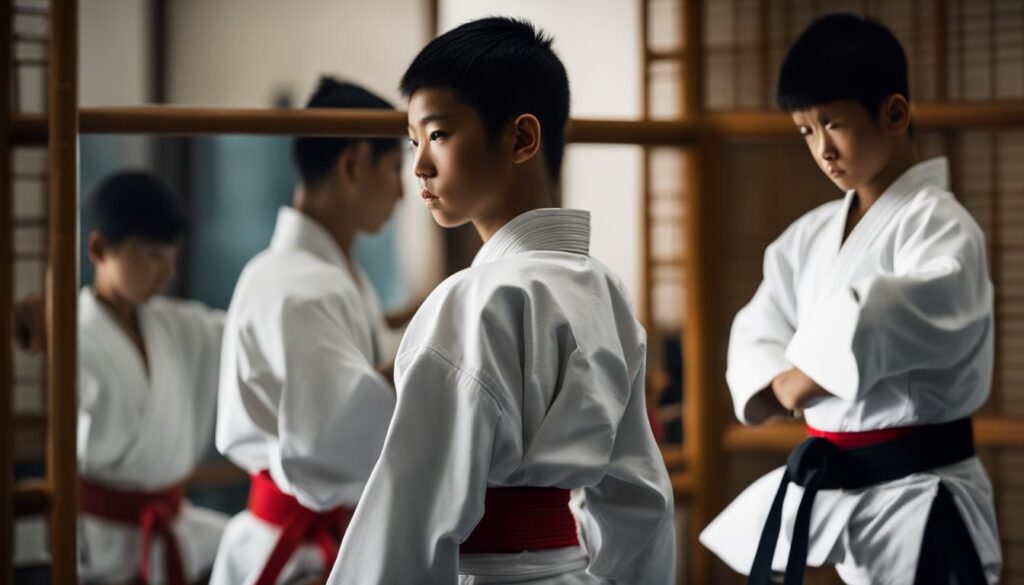
A positive mindset in karate training can enhance your overall performance. When you believe in yourself and approach each technique with confidence, you are more likely to execute it with precision and power. On the other hand, a negative mindset can hinder your progress and prevent you from reaching your full potential.
By maintaining a neat appearance, such as a well-tied karate belt, you are reinforcing your commitment and discipline. It symbolizes your dedication to detail and precision, which are vital aspects of martial arts training. A tidy appearance shows respect and professionalism, both towards yourself and your fellow practitioners.
In addition to a positive mindset, a neatly tied karate belt also fosters a sense of pride and self-confidence. When you look the part, you feel the part. It boosts your self-esteem and helps you approach each training session with enthusiasm and determination.
A positive attitude and a focused mindset not only benefit your individual performance but also contribute to a positive training environment. When you approach training with an open mind and a supportive attitude, you create a space where everyone can thrive and grow together. Your mindset sets the tone for the entire dojo.
Developing a positive mindset takes time and practice. It requires self-awareness, discipline, and an understanding that challenges are opportunities for growth. By continuously working on your mindset, you can unlock your full potential and achieve remarkable progress in your karate training.
Remember, every time you tie your karate belt, take a moment to align your mind, body, and spirit. Embrace the power of a positive mindset and let it guide you on your martial arts journey.
Conclusion
Tying a karate belt correctly is an essential part of martial arts training. It not only ensures a neat and tidy appearance but also reflects your dedication to the art and upholds its traditions. By following the proper techniques and paying attention to detail, you demonstrate your commitment to mastering the martial arts.
Remember, when tying your karate belt, it is important to approach each step with care and intention. Take the time to fold the belt neatly and position it correctly around your waist. Make sure to tighten the knot securely but comfortably to avoid any distractions during your training sessions.
Whether you are a beginner or a seasoned practitioner, always strive for perfection in your karate belt tying. It may seem like a small detail, but it holds significant symbolism within the martial arts community. So, embrace the tradition, honor the discipline, and tie your karate belt with pride.
FAQ
How do I tie a karate belt correctly?
Follow the step-by-step instructions provided in this guide to ensure a proper knot every time.
Why is it important to tie my karate belt correctly?
Tying your karate belt correctly reflects your commitment to attention to detail and respect for the martial arts tradition.
What is the traditional method of tying a karate belt?
The traditional method involves folding the belt in half, placing the center at the navel, and wrapping the ends around the waist.
Are there alternative methods for tying a karate belt?
Yes, an alternative method includes wrapping one end of the belt twice around the waist and tucking the other end under the layers to create a flatter knot.
Any tips for tying a karate belt?
Use a mirror for guidance, ensure evenness, smooth out any wrinkles, and tighten the knot securely but comfortably.
How can I fix uneven ends in my karate belt?
Adjust the ends by sliding the belt around your waist until they are even before proceeding to the next step.
Can I use the same techniques for tying belts in different martial arts?
Yes, the methods described in this guide can be adapted to various martial arts disciplines, such as taekwondo or jiujutsu.
How can I maintain a neatly tied karate belt?
Ensure that the knot remains tight and secure throughout your training session, adjusting the tightness if needed.
What does a well-tied karate belt symbolize?
A well-tied karate belt symbolizes discipline, dedication, and respect for the martial arts.
How should I fold my karate gi properly?
Follow the steps provided in this guide to neatly fold your karate gi after training or washing.
Why is it important to fold my gi properly?
Folding your gi properly demonstrates respect for the martial arts and helps keep it clean and wrinkle-free.
How can I model attention to detail for young students?
By helping young students tie their karate belts correctly, parents can instill values of effort, cleanliness, and respect.
What is the impact of mindset in karate training?
Tying your karate belt correctly and maintaining a neat appearance reflects a positive mindset, which contributes to a more focused and effective training experience.
Any final thoughts on tying a karate belt?
Tying a karate belt correctly is an essential part of martial arts training. Remember to always tie your karate belt with care and intention.
